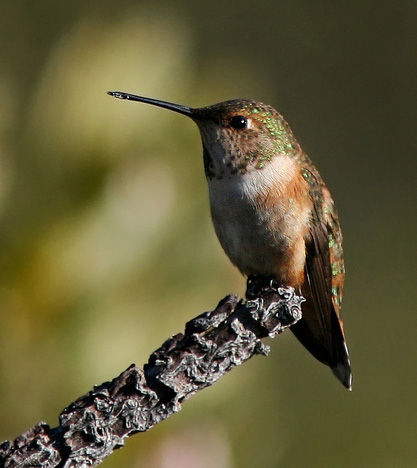
Okay, maybe the headline gave it away, but in case you haven’t figured it out yet, the problem is that big dark shadow on the bird’s breast.
Why did this happen? Simple: I wasn’t keeping an eye on the Sun. I don’t mean that literally, of course. If you really kept an eye on the Sun, you’d go blind pretty quickly (not a good condition for photographers!).
But, when you’re photographing wildlife, it’s a good idea to keep track of the Sun’s position, to avoid harsh shadows from appearing on your subject. You’ll most likely want an evenly lit subject, unless you’re exploring a creative type of photo.
To get the photo above, I searched for a spot where two conditions were met:
- There were lots of hummingbirds flying around
- There were lots of close branches that had good backgrounds
Then, I just waited for hummingbirds to land on the various branches. But, the thing I forgot to consider was the Sun’s position. Only one of the branches had a good background and good lighting (direct sunlight). The rest were either completely in shadows or, like the one above, were only half lit well (the Sun was shining from slightly behind the bird).
Unfortunately, when I returned to the same spot a week later, all the Rufous Hummingbirds had left! Looks like I caught them on the last weekend of their migration 🙁
So, remember: when you’re choosing a spot to photograph wildlife from, always consider where your subject will appear and determine if that spot will have proper lighting. Always keep an eye on the Sun.
If you enjoyed this article, and would like to read more, please signup for free updates by email or RSS.
 About the Author: Steve Berardi is a naturalist, photographer, computer scientist, and founder of PhotoNaturalist. You can usually find him hiking in the San Gabriel Mountains or the Mojave Desert, both located in the beautiful state of California.
About the Author: Steve Berardi is a naturalist, photographer, computer scientist, and founder of PhotoNaturalist. You can usually find him hiking in the San Gabriel Mountains or the Mojave Desert, both located in the beautiful state of California.
I think it’s a great shot. If the light had been “perfect”, it would look more like a studio shot. This maintains a natural look.
Thanks, Jane! I am starting to like the photo a little more, after looking at it so much, haha..
This is a very nice photo. I don’t see any lighting problems.
I totally get what you’re saying. A sigh for you. Likewise, I enjoy seeing the shape of the breast. Would it be as distinct w/ more lighting?
It might be nice to have both versions, since wings can be so iridescent. I am always tornn between a “studio” shot and the natural shot (since I am an amateur). Now know why I walked an entire circle around a herd of male big horn sheep — I was subconsciously worrying about lighting! (The underside of the tail would have been dark regardless of sun position.)
The sun is coming from the right,and got this dark patch at the bird front.There seem to me to get a decent shot of this is to wait till the bird turns to face me whereby the sun will light it up naturally.This is what I think .